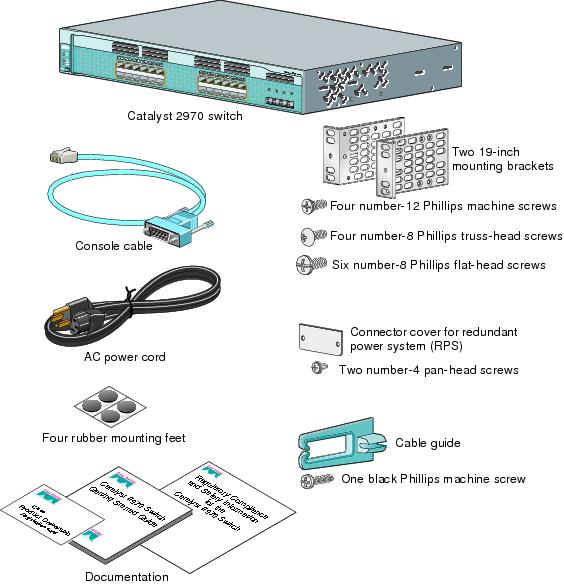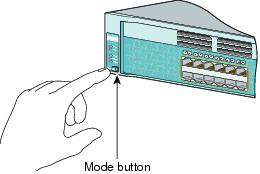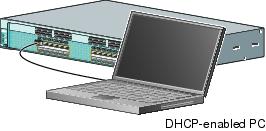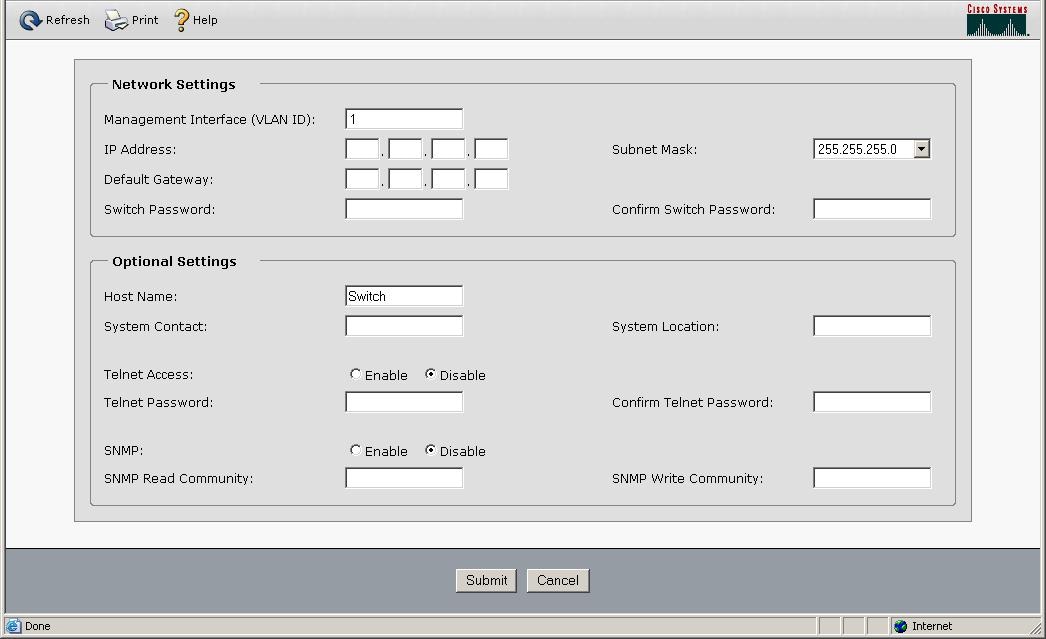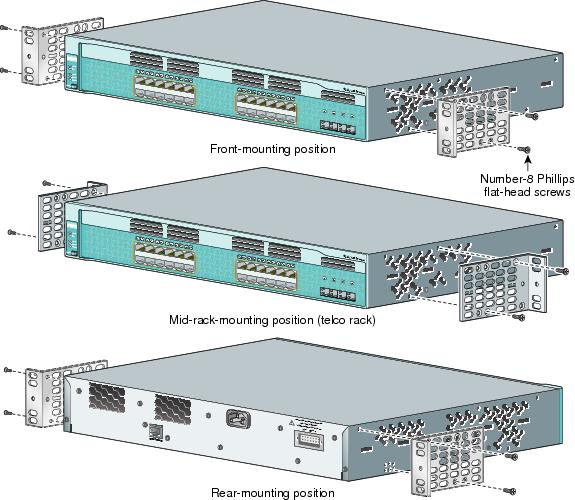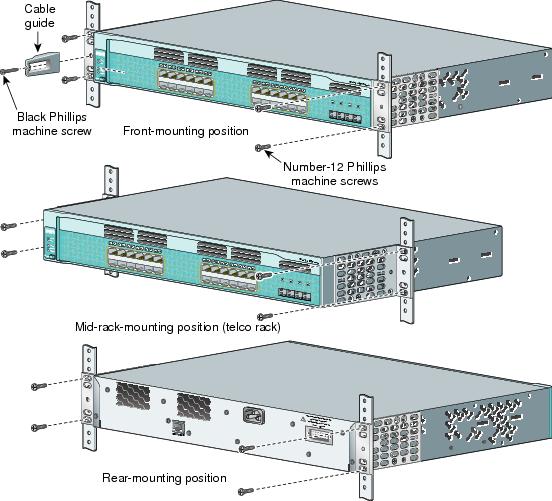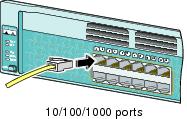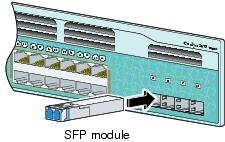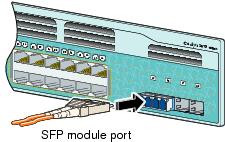 Feedback Feedback
|
Table Of Contents
Catalyst 2970 Switch Getting Started Guide
Equipment That You Supply to Run Express Setup
Downloading Cisco Network Assistant
Installation Warning Statements
Connect to the 10/100/1000 Ports
Install the SFP Modules and Connect to the Ports
Cisco Product Security Overview
Reporting Security Problems in Cisco Products
Obtaining Technical Assistance
Cisco Technical Support Website
Definitions of Service Request Severity
Obtaining Additional Publications and Information
Cisco Limited Lifetime Hardware Warranty Terms
Getting Started Guide
Catalyst 2970 Switch Getting Started Guide
INCLUDING LICENSE AND WARRANTY1 About this Guide
This guide provides instructions on how to use Express Setup to initially configure your Catalyst switch. Also covered are switch management options, basic rack-mounting procedures, port and module connections, power connection procedures, and troubleshooting help.
For additional installation and configuration information for Catalyst 2970 switches, see the Catalyst 2970 documentation on Cisco.com. For system requirements, important notes, limitations, open and resolved bugs, and last-minute documentation updates, see the release notes, also on Cisco.com.
When using the online publications, refer to the documents that match the Cisco IOS software version running on the switch. The software version is on the Cisco IOS label on the switch rear panel.
You can order printed copies of some of the manuals from the Cisco.com sites and from the telephone numbers listed in the "Obtaining Documentation" section.
For translations of the warnings that appear in this publication, see the Regulatory Compliance and Safety Information for the Catalyst 2970 Switch that accompanies this guide.
2 Taking Out What You Need
Follow these steps:
1.
Unpack and remove the switch and the accessory kit from the shipping box.
2.
Return the packing material to the shipping container, and save it for future use.
3.
Verify that you have received the items shown on page 3. If any item is missing or damaged, contact your Cisco representative or reseller for instructions. Some switch models might include additional items that are not shown on page 3.
Equipment That You Supply to Run Express Setup
You need to supply this equipment to run Express Setup:
•
PC
•
Ethernet (Category 5) straight-through cable (as shown)
Shipping Box Contents
3 Running Express Setup
When you first set up the switch, you should use Express Setup to enter the initial IP information. This enables the switch to connect to local routers and the Internet. You can then access the switch through the IP address for further configuration.
To run Express Setup:
Step 1
Verify that no devices are connected to the switch, because during Express Setup, the switch acts as a DHCP server. If your PC has a static IP address, before you begin you should change your PC settings to temporarily use DHCP.
Step 2
Connect the AC power cord to the switch and to a grounded AC outlet. The power-on self-test (POST) begins. During POST, the LEDs blink while a series of tests verify that the switch functions properly.
Step 3
Wait for the switch to complete POST. It might take several minutes for the switch to complete POST.
Step 4
Verify that POST has completed by confirming that the SYST LED rapidly blinks green. If the switch fails POST, the SYST LED turns amber.
POST errors are usually fatal. Call Cisco Systems immediately if your switch fails POST.
Step 5
Press and hold the Mode button for 3 seconds. When all of the LEDs above the Mode button turn green, release the Mode button.
If the LEDs above the Mode button begin to blink after you press the button, release it. Blinking LEDs mean that the switch has already been configured and cannot go into Express Setup mode. For more information, see the "Resetting the Switch" section.
Step 6
Verify that the switch is in Express Setup mode by confirming that all LEDs above the Mode button are green. (The RPS LED remains off on some switch models.)
Step 7
Connect a straight-through Category 5 Ethernet cable (not provided) to any 10/100/1000 Ethernet port on the switch front panel and to the Ethernet port on the PC.
Step 8
Verify that the LEDs on both Ethernet ports are green.
Step 9
Wait 30 seconds.
Step 10
Launch a web browser on your PC. Enter the IP address 10.0.0.1 in the web browser, and press Enter.
Step 11
The Express Setup page appears. If it does not appear, see the "In Case of Difficulty" section for help.
Step 12
Enter this information in the Network Settings fields:
•
In the Management Interface (VLAN ID) field, the default is 1. Enter a new VLAN ID only if you want to change the management interface through which you manage the switch and to which you assign IP information. The VLAN ID range is 1 to 1001.
•
In the IP Address field, enter the IP address of the switch. In the IP Subnet Mask field, click the drop-down arrow, and select an IP Subnet Mask.
•
In the Default Gateway field, enter the IP address for the default gateway (router).
•
Enter your password in the Switch Password field. The password can be from 1 to 25 alphanumeric characters, can start with a number, is case sensitive, allows embedded spaces, but does not allow spaces at the beginning or end. In the Confirm Switch Password field, enter your password again.
Step 13
(Optional) You can enter the Optional Settings information now or enter it later by using the device manager interface:
•
In the Host Name field, enter a name for the switch. The host name is limited to 31 characters; embedded spaces are not allowed.
•
In the System Contact field, enter the name of the person responsible for the switch. In the System Location field, enter the wiring closet, floor, or building where the switch is located.
•
In the Telnet Access field, click Enable if you are going to use Telnet to manage the switch by using the command-line interface (CLI). If you enable Telnet access, you must enter a Telnet password.
•
In the Telnet Password field, enter a password. The Telnet password can be from 1 to 25 alphanumeric characters, is case sensitive, allows embedded spaces, but does not allow spaces at the beginning or end. In the Confirm Telnet Password field, enter the Telnet password again.
•
In the SNMP field, click Enable to enable Simple Network Management Protocol (SNMP). Enable SNMP only if you plan to manage switches by using CiscoWorks2000 or another SNMP-based network-management system.
If you enable SNMP, you must enter a community string in the SNMP Read Community field, the SNMP Write Community field, or both. SNMP community strings authenticate access to MIB objects. Embedded spaces are not allowed in SNMP community strings. When you set the SNMP read community, you can access SNMP information, but cannot modify it. When you set the SNMP write community, you can access and modify SNMP information.
Step 14
Click Submit to save your settings, or click Cancel to clear your settings.
When you click Submit, the switch is configured and exits Express Setup mode. The PC displays a warning message and then attempts to connect with the new switch IP address. If you configured the switch with an IP address that is in a different subnet from the PC, connectivity between the PC and the switch is lost.
Step 15
Disconnect the switch from the PC, and install the switch in your production network. See the "Managing the Switch" section for information about configuring and managing the switch.
If you need to rerun Express Setup, see the "Resetting the Switch" section.
Refreshing the PC IP Address
After you complete Express Setup, you should refresh the PC IP address.
For a dynamically assigned IP address, disconnect the PC from the switch, and reconnect it to the network. The network DHCP server will assign a new IP address to the PC.
For a statically assigned IP address, change it to the previously configured IP address.
4 Managing the Switch
After completing Express Setup and installing the switch in your network, use the device manager or other management options described in this section for further configuration.
Using the Device Manager
The simplest way to manage the switch is by using the device manager that is in the switch memory. This is an easy-to-use web interface that offers quick configuration and monitoring. You can access the device manager from anywhere in your network through a web browser.
Follow these steps:
1.
Launch a web browser on your PC or workstation.
2.
Enter the switch IP address in the web browser, and press Enter. The device manager page appears.
3.
Use the device manager to perform basic switch configuration and monitoring. Refer to the device manager online help for more information.
4.
For more advanced configuration, download and run the Cisco Network Assistant described in the next section.
Downloading Cisco Network Assistant
Cisco Network Assistant is a software program that you download from Cisco.com and run on your PC. It offers advanced options for configuring and monitoring multiple devices, including switches, switch clusters, switch stacks, routers, and access points. Network Assistant is free—there is no charge to download, install, or use it.
Follow these steps:
1.
Go to this Web address: http://www.cisco.com/go/NetworkAssistant.
You must be a registered Cisco.com user, but you need no other access privileges.
2.
Find the Network Assistant installer.
3.
Download the Network Assistant installer, and run it. (You can run it directly from the Web if your browser offers this choice.)
4.
When you run the installer, follow the displayed instructions. In the final panel, click Finish to complete the Network Assistant installation.
Refer to the Network Assistant online help and the getting started guide for more information.
Command-Line Interface
You can enter Cisco IOS commands and parameters through the CLI. Access the CLI either by connecting your PC directly to the switch console port or through a Telnet session from a remote PC or workstation.
Follow these steps:
1.
Connect the supplied RJ-45-to DB-9 adapter cable to the standard 9-pin serial port on the PC. Connect the other end of the cable to the console port on the switch.
2.
Start a terminal-emulation program on the PC.
3.
Configure the PC terminal emulation software for 9600 baud, 8 data bits, no parity, 1 stop bit, and no flow control.
4.
Use the CLI to enter commands to configure the switch. See the software configuration guide and the command reference for more information.
Other Management Options
You can use SNMP management applications such as CiscoWorks Small Network Management Solution (SNMS) and HP OpenView to configure and manage the switch. You also can manage it from an SNMP-compatible workstation that is running platforms such as HP OpenView or SunNet Manager.
The Cisco IE2100 Series Configuration Registrar is a network management device that works with embedded CNS agents in the switch software. You can use IE2100 to automate initial configurations and configuration updates on the switch.
See the "Accessing Help Online" section for a list of supporting documentation.
5 Rack-Mounting
This section covers basic 19-inch rack-mounting and switch port connections. As an example, all the illustrations show the Catalyst 2970G-24TS switch. You can install and connect the Catalyst 2970G-24T switch as shown in these illustrations. For alternate mounting procedures, such as installing the switch in a 24-inch rack or on a wall, and for additional cabling information, see the Catalyst 2970 Switch Hardware Installation Guide on Cisco.com.
Equipment That You Supply
You need to supply a number-2 Phillips screwdriver to rack-mount the switch.
Before You Begin
When determining where to install the switch, verify that these guidelines are met:
Installation Warning Statements
This section includes the basic installation warning statements. Translations of these warning statements appear in the Regulatory Compliance and Safety Information for the Catalyst 2970 Switch document that shipped with the switch.
WarningOnly trained and qualified personnel should be allowed to install, replace, or service this equipment. Statement 148
WarningInstallation of the equipment must comply with local and national electrical codes. Statement 1074
WarningThis equipment is intended to be grounded. Ensure that the host is connected to earth ground during normal use. Statement 39
WarningIf a redundant power system (RPS) is not connected to the switch, install an RPS connector cover on the back of the switch. Statement 265
WarningClass 1 laser product. Statement 1008
WarningFor connections outside the building where the equipment is installed, the following ports must be connected through an approved network termination unit with integral circuit protection: 10/100/1000 Ethernet. Statement 1044
Attaching the Brackets
Use four Phillips flat-head screws to attach the long side of the brackets to Catalyst 2970 switches in one of three mounting positions.
Rack-Mount the Switch
Use the black Phillips machine screw to attach the cable guide to the left or right bracket. Use the four number-12 Phillips machine screws to attach the brackets to the rack.
Connect to the Switch Ports
This section describes how to connect to the fixed switch ports and to the SFP module ports.
Connect to the 10/100/1000 Ports
Follow these steps:
Step 1
When you connect to servers, workstations, IP phones, wireless access points, and routers, insert a straight-through, twisted four-pair, Category 5 cable in a switch 10/100/1000 port. Use a crossover, twisted four-pair, Category 5 cable when you connect to other switches, hubs, or repeaters.
Step 2
Insert the other cable end into an RJ-45 connector on the other device.
Note
The automatic medium-dependent interface crossover (Auto-MDIX) feature is enabled by default on switches running Cisco IOS Release 12.2(18)SE or later. When the Auto-MDIX feature is enabled, the switch detects the required cable type for copper Ethernet connections and configures the interfaces accordingly. Therefore, you can use either a crossover or a straight-through cable for connections to a copper 10/100/1000 or 1000BASE-T SFP module port on the switch, regardless of the type of device on the other end of the connection.
Install the SFP Modules and Connect to the Ports
Follow these steps:
Step 1
Grasp the module on the sides, and insert it into the switch slot until you feel the connector snap into place.
Step 2
Insert an appropriate cable into the module port. Insert the other cable end into the other device.
For a list of supported modules, see the release notes on Cisco.com. For detailed instructions on installing, removing, and connecting to SFP modules, see the documentation that came with the SFP module.
CautionRemoving and installing an SFP module can shorten its useful life. Do not remove and insert SFP modules more often than is absolutely necessary.
Verify Port Connectivity
After you connect to the switch port, the port LED turns amber while the switch establishes a link. This process takes about 30 seconds, and then the LED turns green when the switch and the target device have an established link. If the LED is off, the target device might not be turned on, there might be a cable problem, or there might be a problem with the adapter installed in the target device. See the "In Case of Difficulty" section for information about online assistance.
6 In Case of Difficulty
If you experience difficulty, help is available here and on Cisco.com. This section includes Express Setup troubleshooting, how to reset the switch, how to access help online, and where to find more information.
Troubleshooting Express Setup
If Express Setup does not run, or if the Express Setup page does not appear in your browser:
•
Did you verify that POST successfully ran before starting Express Setup?
If not, make sure that only the SYST and STAT LEDs are green before pressing the Mode button to enter the Express Setup mode.
•
Did you press the Mode button while the switch was still running POST?
If yes, wait until POST completes. Power cycle the switch. Wait until POST completes. Confirm that the SYST and STAT LEDs are green. Press the Mode button to enter Express Setup mode.
•
Did you try to continue without confirming that the switch was in Express Setup mode?
Verify that all LEDs above the Mode button are green. (The RPS LED is off.) If necessary, press the Mode button to enter Express Setup mode.
•
Does your PC have a static IP address?
If yes, before connecting to the switch, change your PC settings to temporarily use DHCP.
•
Did you connect a crossover cable instead of a straight-through Ethernet cable between a switch port and the Ethernet port of the PC?
If yes, connect a straight-through cable to an Ethernet port on the switch and the PC. Wait 30 seconds before entering 10.0.0.1 in the browser.
•
Did you connect the Ethernet cable to the console port instead of to a 10/100/1000 Ethernet port on the switch?
If yes, disconnect from the console port. Connect to an Ethernet port on the switch and the PC. Wait 30 seconds before entering 10.0.0.1 in the browser.
•
Did you wait 30 seconds after connecting the switch and the PC before entering the IP address in your browser?
If not, wait 30 seconds, re-enter 10.0.0.1 in the browser, and press Enter.
•
Did you enter the wrong address in the browser, or is there an error message?
If yes, re-enter 10.0.0.1 in the browser, and press Enter.
Resetting the Switch
This section describes how to reset the switch by rerunning Express Setup. These are reasons why you might want to reset the switch:
•
You installed the switch in your network and cannot connect to it because you assigned the wrong IP address.
•
You want to clear all configuration from the switch and assign a new IP address.
•
You are trying to enter Express Setup mode, and the switch LEDs start blinking when you press the Mode button (which means that the switch is already configured with IP information).
CautionResetting the switch deletes the configuration and reboots the switch.
To reset the switch:
•
Press and hold the Mode button. The switch LEDs begin blinking after about 3 seconds. Continue holding down the Mode button. The LEDs stop blinking after 7 more seconds, and then the switch reboots.
The switch now behaves like an unconfigured switch. You can enter the switch IP information by using Express Setup as described in the "Running Express Setup" section.
Accessing Help Online
First look for a solution to your problem in the troubleshooting section of the Catalyst 2970 Hardware Installation Guide or the Catalyst 2970 Software Configuration Guide on Cisco.com. You can also access the Cisco Technical Support and Documentation website for a list of known hardware problems and extensive troubleshooting documentation, including:
•
Factory defaults and password recovery
•
Recovery from corrupted or missing software
•
Switch port problems
•
Network interface cards
•
Troubleshooting tools
•
Field notices and security advisories
Follow these steps:
1.
Open your browser, and go to http://www.cisco.com/.
2.
Click Technical Support.
3.
Click Product Support > Switches > LAN and ATM Switches > Catalyst 2970 Series Switches > Troubleshooting.
4.
Click the subject that addresses the problem that you are experiencing.
For More Information
For more information about the switch, see these documents on Cisco.com:
•
Catalyst 2970 Switch Hardware Installation Guide (not orderable, but available on Cisco.com). This guide provides complete hardware descriptions and detailed installation procedures.
•
Regulatory Compliance and Safety Information for the Catalyst 2970 Switch (order number DOC-7816686=). This guide contains agency approvals, compliance information, and translated warning statements.
•
Release Notes for the Catalyst 2970 Switch (not orderable but available on Cisco.com)
•
Catalyst 2970 Switch Software Configuration Guide (order number DOC-7815462=). This guide provides a product overview and detailed descriptions and procedures of the switch software features.
•
Catalyst 2970 Switch Command Reference (order number DOC-7815464=). This reference provides detailed descriptions of the Cisco IOS commands specifically created or modified for the switch.
•
Catalyst 2970 Switch System Message Guide (order number DOC-7815465=). This guide provides descriptions of the system messages specifically created or modified for the switch.
7 Obtaining Documentation
Cisco documentation and additional literature are available on Cisco.com. Cisco also provides several ways to obtain technical assistance and other technical resources. These sections explain how to obtain technical information from Cisco Systems.
Cisco.com
You can access the most current Cisco documentation at this URL:
http://www.cisco.com/univercd/home/home.htm
You can access the Cisco website at this URL:
You can access international Cisco websites at this URL:
http://www.cisco.com/public/countries_languages.shtml
Documentation DVD
Cisco documentation and additional literature are available in a Documentation DVD package, which may have shipped with your product. The Documentation DVD is updated regularly and may be more current than printed documentation. The Documentation DVD package is available as a single unit.
Registered Cisco.com users (Cisco direct customers) can order a Cisco Documentation DVD (product number DOC-DOCDVD=) from the Ordering tool or Cisco Marketplace.
Cisco Ordering tool:
http://www.cisco.com/en/US/partner/ordering/
Cisco Marketplace:
http://www.cisco.com/go/marketplace/
Ordering Documentation
You can find instructions for ordering documentation at this URL:
http://www.cisco.com/univercd/cc/td/doc/es_inpck/pdi.htm
You can order Cisco documentation in these ways:
•
Registered Cisco.com users (Cisco direct customers) can order Cisco product documentation from the Ordering tool:
http://www.cisco.com/en/US/partner/ordering/
•
Nonregistered Cisco.com users can order documentation through a local account representative by calling Cisco Systems Corporate Headquarters (California, USA) at 408 526-7208 or, elsewhere in North America, by calling 1 800 553-NETS (6387).
8 Documentation Feedback
You can send comments about technical documentation to bug-doc@cisco.com.
You can submit comments by using the response card (if present) behind the front cover of your document or by writing to the following address:
Cisco Systems
Attn: Customer Document Ordering
170 West Tasman Drive
San Jose, CA 95134-9883We appreciate your comments.
9 Cisco Product Security Overview
Cisco provides a free online Security Vulnerability Policy portal at this URL:
http://www.cisco.com/en/US/products/products_security_vulnerability_policy.html
From this site, you can perform these tasks:
•
Report security vulnerabilities in Cisco products.
•
Obtain assistance with security incidents that involve Cisco products.
•
Register to receive security information from Cisco.
A current list of security advisories and notices for Cisco products is available at this URL:
If you prefer to see advisories and notices as they are updated in real time, you can access a Product Security Incident Response Team Really Simple Syndication (PSIRT RSS) feed from this URL:
http://www.cisco.com/en/US/products/products_psirt_rss_feed.html
Reporting Security Problems in Cisco Products
Cisco is committed to delivering secure products. We test our products internally before we release them, and we strive to correct all vulnerabilities quickly. If you think that you might have identified a vulnerability in a Cisco product, contact PSIRT:
•
Emergencies — security-alert@cisco.com
•
Nonemergencies — psirt@cisco.com
Tip
We encourage you to use Pretty Good Privacy (PGP) or a compatible product to encrypt any sensitive information that you send to Cisco. PSIRT can work from encrypted information that is compatible with PGP versions 2.x through 8.x.
Never use a revoked or an expired encryption key. The correct public key to use in your correspondence with PSIRT is the one that has the most recent creation date in this public key server list:
http://pgp.mit.edu:11371/pks/lookup?search=psirt%40cisco.com&op=index&exact=onIn an emergency, you can also reach PSIRT by telephone:
•
1 877 228-7302
•
1 408 525-6532
10 Obtaining Technical Assistance
For all customers, partners, resellers, and distributors who hold valid Cisco service contracts, Cisco Technical Support provides 24-hour-a-day, award-winning technical assistance. The Cisco Technical Support Website on Cisco.com features extensive online support resources. In addition, Cisco Technical Assistance Center (TAC) engineers provide telephone support. If you do not hold a valid Cisco service contract, contact your reseller.
Cisco Technical Support Website
The Cisco Technical Support Website provides online documents and tools for troubleshooting and resolving technical issues with Cisco products and technologies. The website is available 24 hours a day, 365 days a year, at this URL:
http://www.cisco.com/techsupport
Access to all tools on the Cisco Technical Support Website requires a Cisco.com user ID and password. If you have a valid service contract but do not have a user ID or password, you can register at this URL:
http://tools.cisco.com/RPF/register/register.do
Note
Use the Cisco Product Identification (CPI) tool to locate your product serial number before submitting a web or phone request for service. You can access the CPI tool from the Cisco Technical Support Website by clicking the Tools & Resources link under Documentation & Tools. Choose Cisco Product Identification Tool from the Alphabetical Index drop-down list, or click the Cisco Product Identification Tool link under Alerts & RMAs. The CPI tool offers three search options: by product ID or model name; by tree view; or for certain products, by copying and pasting show command output. Search results show an illustration of your product with the serial number label location highlighted. Locate the serial number label on your product and record the information before placing a service call.
Submitting a Service Request
Using the online TAC Service Request Tool is the fastest way to open S3 and S4 service requests. (S3 and S4 service requests are those in which your network is minimally impaired or for which you require product information.) After you describe your situation, the TAC Service Request Tool provides recommended solutions. If your issue is not resolved using the recommended resources, your service request is assigned to a Cisco TAC engineer. The TAC Service Request Tool is located at this URL:
http://www.cisco.com/techsupport/servicerequest
For S1 or S2 service requests or if you do not have Internet access, contact the Cisco TAC by telephone. (S1 or S2 service requests are those in which your production network is down or severely degraded.) Cisco TAC engineers are assigned immediately to S1 and S2 service requests to help keep your business operations running smoothly.
To open a service request by telephone, use one of the following numbers:
Asia-Pacific: +61 2 8446 7411 (Australia: 1 800 805 227)
EMEA: +32 2 704 55 55
USA: 1 800 553-2447For a complete list of Cisco TAC contacts, go to this URL:
http://www.cisco.com/techsupport/contacts
Definitions of Service Request Severity
To ensure that all service requests are reported in a standard format, Cisco has established severity definitions.
Severity 1 (S1)—Your network is "down," or there is a critical impact to your business operations. You and Cisco will commit all necessary resources around the clock to resolve the situation.
Severity 2 (S2)—Operation of an existing network is severely degraded, or significant aspects of your business operation are negatively affected by inadequate performance of Cisco products. You and Cisco will commit full-time resources during normal business hours to resolve the situation.
Severity 3 (S3)—Operational performance of your network is impaired, but most business operations remain functional. You and Cisco will commit resources during normal business hours to restore service to satisfactory levels.
Severity 4 (S4)—You require information or assistance with Cisco product capabilities, installation, or configuration. There is little or no effect on your business operations.
11 Obtaining Additional Publications and Information
Information about Cisco products, technologies, and network solutions is available from various online and printed sources.
•
Cisco Marketplace provides a variety of Cisco books, reference guides, and logo merchandise. Visit Cisco Marketplace, the company store, at this URL:
http://www.cisco.com/go/marketplace/
•
Cisco Press publishes a wide range of general networking, training and certification titles. Both new and experienced users will benefit from these publications. For current Cisco Press titles and other information, go to Cisco Press at this URL:
•
Packet magazine is the Cisco Systems technical user magazine for maximizing Internet and networking investments. Each quarter, Packet delivers coverage of the latest industry trends, technology breakthroughs, and Cisco products and solutions, as well as network deployment and troubleshooting tips, configuration examples, customer case studies, certification and training information, and links to scores of in-depth online resources. You can access Packet magazine at this URL:
•
iQ Magazine is the quarterly publication from Cisco Systems designed to help growing companies learn how they can use technology to increase revenue, streamline their business, and expand services. The publication identifies the challenges facing these companies and the technologies to help solve them, using real-world case studies and business strategies to help readers make sound technology investment decisions. You can access iQ Magazine at this URL:
http://www.cisco.com/go/iqmagazine
•
Internet Protocol Journal is a quarterly journal published by Cisco Systems for engineering professionals involved in designing, developing, and operating public and private internets and intranets. You can access the Internet Protocol Journal at this URL:
•
World-class networking training is available from Cisco. You can view current offerings at this URL:
http://www.cisco.com/en/US/learning/index.html
12 Cisco Limited Lifetime Hardware Warranty Terms
There are special terms applicable to your hardware warranty and various services that you can use during the warranty period. Your formal Warranty Statement, including the warranties and license agreements applicable to Cisco software, is available on Cisco.com. Follow these steps to access and download the Cisco Information Packet and your warranty and license agreements from Cisco.com.
1.
Launch your browser, and go to this URL:
http://www.cisco.com/univercd/cc/td/doc/es_inpck/cetrans.htm
The Warranties and License Agreements page appears.
2.
To read the Cisco Information Packet, follow these steps:
a.
Click the Information Packet Number field, and make sure that the part number 78-5235-03A0 is highlighted.
b.
Select the language in which you would like to read the document.
c.
Click Go.
The Cisco Limited Warranty and Software License page from the Information Packet appears.
d.
Read the document online, or click the PDF icon to download and print the document in Adobe Portable Document Format (PDF).
3.
To read translated and localized warranty information about your product, follow these steps:
a.
Enter this part number in the Warranty Document Number field:
78-6310-02C0
b.
Select the language in which you would like to view the document.
c.
Click Go.
The Cisco warranty page appears.
d.
Read the document online, or click the PDF icon to download and print the document in Adobe Portable Document Format (PDF).
You can also contact the Cisco service and support website for assistance:
http://www.cisco.com/public/Support_root.shtml.
Duration of Hardware Warranty
A Cisco product hardware warranty is supported for as long as the original end user continues to own or use the product, provided that the fan and power supply warranty is limited to five (5) years. In the event of a discontinuance of product manufacture, the Cisco warranty support is limited to five (5) years from the announcement of the discontinuance.
Replacement, Repair, or Refund Policy for Hardware
Cisco or its service center will use commercially reasonable efforts to ship a replacement part within ten (10) working days after receipt of the Return Materials Authorization (RMA) request. Actual delivery times can vary, depending on the customer location.
Cisco reserves the right to refund the purchase price as its exclusive warranty remedy.
To Receive a Return Materials Authorization (RMA) Number
Contact the company from whom you purchased the product. If you purchased the product directly from Cisco, contact your Cisco Sales and Service Representative.
Complete the information below, and keep it for reference.
Company product purchased from
Company telephone number
Product model number
Product serial number
Maintenance contract number

